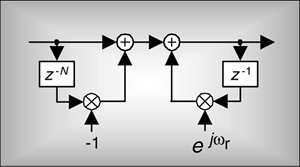Chapter Seven. Specialized Lowpass FIR Filters
Seven Specialized Lowpass FIR Filters

In this chapter we present two implementations used to build computationally efficient, linear phase, finite impulse response (FIR) filters. We discuss these special FIR filters now because their behavior will be easier to understand using the z-transform concepts introduced in the last chapter.
The first filter type presented is called frequency sampling filters. They are in that special class of linear phase finite impulse response (FIR) filters built with recursive structures (using feedback). The Section 7.1 material is a bit advanced for DSP beginners, but it deserves study for two reasons. First, these filters can be very efficient (minimized computational workload) for narrowband lowpass filtering applications; and second, understanding their operation and design reinforces much of the DSP theory covered in previous chapters.
Section 7.2 discusses interpolated lowpass FIR filters. These filters, implemented with nonrecursive structures (no feedback), cascade multiple FIR filters to reduce computational workload. Their implementation is an innovative approach where more than one unit time delay separates the multipliers in a traditional tapped delay line structure.
The common thread among these two filter types is they're lean mean filtering machines. They wring every last drop of computational efficiency from a guaranteed stable, linear phase filter. In many lowpass filtering applications these FIR filter types can attain greatly reduced computational workloads compared to the traditional Parks-McClellan–designed FIR filters discussed in Chapter 5.
 |
Amazon |  |
